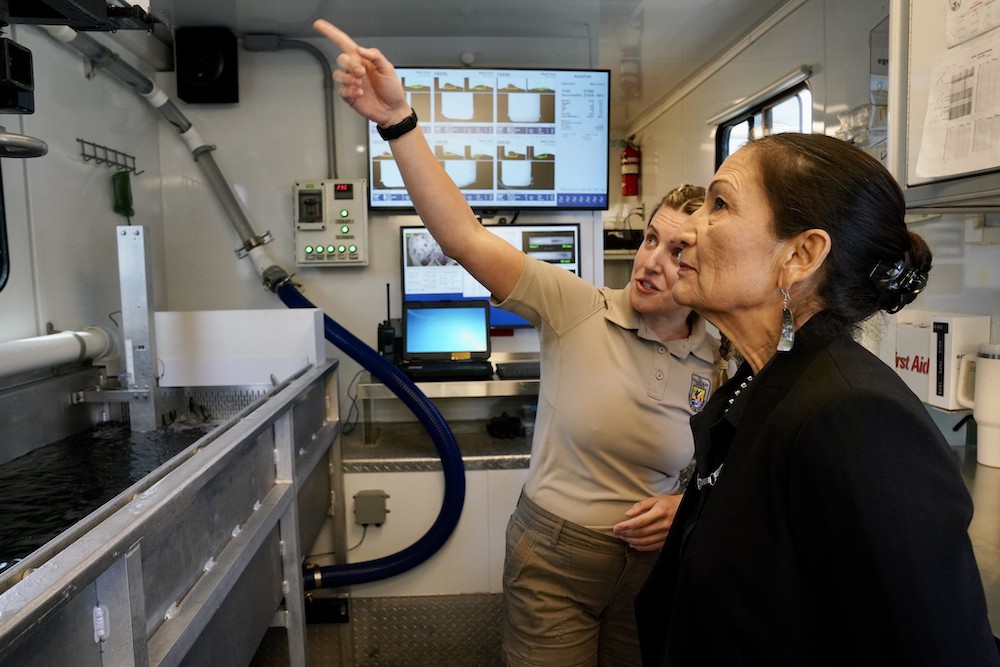
- Details
- By Deb Haaland, Secretary of the Interior
- Opinion | Op-Ed
Guest Opinion. Fifty years ago, President Ford signed the Indian Self-Determination and Education Assistance Act of 1975 into law. This seminal law – the product of tireless Native activism that rallied against a centuries-long status quo – changed how tribal governments serve their people. It solidified that, while the federal government is a partner with trust and treaty obligations to tribes, it is tribes that know best what their people need from their governments.
On this 50th anniversary, I’m reflecting on the progress that has been made in support of Indian Country’s self-determination – progress demanded by our people and promised by the Biden-Harris administration. Nearly four years after this administration's journey began, Indian self-determination hasn’t just endured. It has flourished.
Since day one, we have wasted no time putting pen to paper on the priorities Indian Country demanded of us. This commitment has been demonstrated in the ways we have changed how tribal leaders are engaged in policy discussions, the historic investments that have been made and the changes we have made to ensure this progress is enduring.
From a rapid increase in consultations (which began with a consultation on consultations), to the creation of the Interior Department’s first-ever Secretary’s Tribal Advisory Committee, we have brought tribal leaders directly to the decision-making table to weigh in and affect decisions before they are made. That work has contributed to progress in a number of policy areas, from leasing and development decisions, to Colorado River negotiations and the stewardship of salmon in the Pacific Northwest and Alaska.
Tribes also had a say in how we directed investments from the American Rescue Plan, Bipartisan Infrastructure Law and Inflation Reduction Act to their communities – an unprecedented $45 billion from President Biden’s Investing in America agenda. These resources will help underpin tribal self-determination regardless of what the future holds.
We have delivered water to communities like the Hopi Tribe in Arizona, which now enjoys access to an expanded water system and clean water after decades of unsafe groundwater containing elevated levels of arsenic. Thanks to our Tribal Electrification Program and nearly $150 million, tribes like the Rosebud Sioux Tribe of South Dakota are electrifying homes on tribal lands for a more climate resilient future. We’ve directed historic funding to clean up legacy pollution like orphaned oil and gas wells that harm our air, water, and soil. And for tribes on the front lines of the climate crisis, we have infused millions of dollars into climate relocation and adaptation planning so that communities like the Native Village of Napakiak in Alaska can move to safer ground without abandoning their homelands.
Our administration has prioritized efforts that will empower tribal self-determination long after this administration comes to an end. That includes leveraging co-stewardship agreements, which commit tribes and the federal government to the shared co-management of certain public lands and waters. Our administration has entered into over 400 co-stewardship agreements with tribes. Since time immemorial, ancestral homelands have been central to the social, cultural, spiritual, mental and physical wellbeing of Indigenous peoples. Through this unprecedented number of co-stewardship agreements, the Biden-Harris administration has demonstrated our commitment to acknowledge and empower tribes as partners in the management of our nation’s lands and waters. From the transfer of the Dworshak National Fish Hatchery to the Nez Perce Tribe in Idaho to the historic co-management of Bears Ears National Monument in Utah, we are working together for the shared stewardship of ancestral homelands, with Indigenous Knowledge as our guide.
We recognize that tribes need their own access to capital if they are to succeed in investing in their people, and on their terms. With tools like the Buy Indian Act, our Department has had an outsized impact on improving the economies of tribes and Native business leaders. This past year alone, Interior awarded over $1.4 billion in contracts to Indian-owned and controlled businesses – up from just 317 million in Fiscal Year 2019.
Now, it’s time to raise the bar even higher. In partnership with Native Americans in Philanthropy and our colleagues at the Departments of Commerce, Treasury, Agriculture, the Small Business Administration and the Office of the Comptroller of the Currency, we announced the launch of the Tribal Community Vision Partnership earlier this year. Over the next seven years, the Vision Partnership will raise and deploy $1.2 billion in impact for tribal communities – a historic effort that will support priorities like community development, new clean energy opportunities and support for Native small businesses.
Now more than ever, these types of partnerships and allyship will be needed. By working together with partners in the philanthropic and private sector, I know we can support the advancements that have been made over the last four years to support tribes' self-determination and their right to govern and grow on their own terms.
As I reflect on what the last 50 years of self-determination has looked like for tribal nations, I recognize that our work is not finished. There are more battles to win and more struggles to wage. The road to our full empowerment still sits in front of us, ready for our journey. But today, on the anniversary of the law that changed so much for Indian Country, that road is less steep and less uncertain.
Our new era continues, and we must commit to use our power and our voices to ensure that the progress we have made outlasts us – for another 50 years and beyond.
Deb Haaland (Laguna Pueblo) is the 54th U.S. Secretary of the Interior.